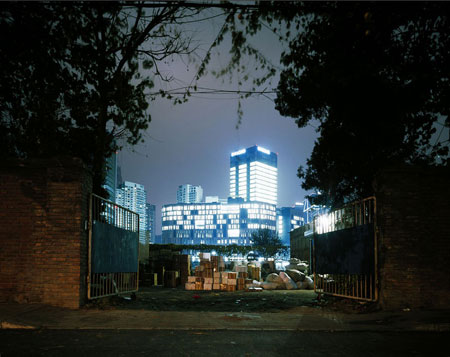Since Deng Xiaoping carried out the reform and opening-up policy
starting in 1978, China has experienced great changes in its urban
landscapes. Especially in recent decades, thanks to economic
prosperity, many skyscrapers have appeared in China's larger
cities. What impression do the millions of new city residents have
of these giant buildings?
Luminant-03,
2007
Photographer Jiang Pengyi, via his two series
All Back to Dust and Luminant, displays a
dreadful fascination for skyscrapers. Jiang's works are being
exhibited at the Paris-Beijing Photo Gallery from Jan. 19 to Feb.
22 inside Beijing's Dashanzi 798, a new but already internationally
known art district.
|

Jiang Pengyi
|
Jiang was born in Hunan in 1977. As a child of the Reform
Policy, he is from a generation for whom construction and
destruction are the competing heads of an accelerated development
that has particularly affected the big cities. Originally from a
small village, he left at a very young age for the big city. Now,
having lived in Beijing for more than ten years, he expresses, via
his photography, the deep social malaise engendered by
modernization.
In Luminant, skyscrapers represent new landmarks in
modern cities. Taken with a large format camera using long exposure
times and framed in light boxes to accentuate their brightness,
Jiang's overexposed buildings seem to warn the viewers about the
negative manipulative power of these structures. In the picture
The Society of Spectacle which depicts multi-layered and
anonymous metropolises, skyscrapers embody a frightening
reflection.
"With their commercial brand names and strip-lighting, these
towers have immense power to fascinate and seduce," Perrine Pautre,
manager of the Paris-Beijing Photo Gallery, said. "If we easily see
the reference to city attractions carried out in the countryside,
this fascination will actually become universal and result in
alienation for everyone. These towers echo back human desires;
continuously renewed, they are unrelentingly unappeased."

Luminant-09,
2007

Luminant-08,
2007
"Image suffices to guarantee value, and city lighting reflects
the individual's desires. It’s not innocent, especially when you
note that Jiang's buildings are all commercial malls or
governmental and press institutions," Perrine added.
Interestingly, in All Back to Dust, the skyscrapers,
these a priori invincible towers, now appear obsolete. Reduced, put
upside down, mixed with plastic bags and rubbish, the buildings
appear greatly reduced, less spectacular. As any construction
involves destruction, Jiang's skyscrapers now appear as relics of a
worn out world, garbage in a new era, with nature reclaiming her
rightful place.

All Back to
Dust-02, 2006
As the sacred Buddhist texts said: big things are also piles of
dust.? "By creating this, I felt a lot better," Jiang Pengyi
told China.org.cn.
Jiang commented that his apocalyptic vision seems milder than
the modern reality.

All Back to Dust-01,
2006

All Back to Dust-03,
2006
Dates: Jan.19-Feb. 22? Everyday, from 10
am to 6 pm
Venue: Paris-Beijing Photo Gallery
Phone: +86-10-8459 9263
Address: Dashanzi 798, No.4 Jiuxianqiao Rd,
Chaoyang District
Website:?
http://www.parisbeijingphotogallery.com/main/jiangpengyiworks.asp
(China.org.cn by Wang Zhiyong January 21, 2008)